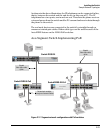
2-24
Installing the Switch
Sample Network Topologies
The 2520G-PoE switches also work well as segment switches. That is, with
their high performance, they can be used for interconnecting network
segments—simply connect the network devices that form those segments to
the 2520G-PoE switches.
In the illustration above, 2520G-PoE switches with PCs, printers, and local
servers attached, are both connected to a non-PoE switch. The devices
attached to the two 2520G-PoE switches can now communicate with each
other through the non-PoE switch. They can also all communicate with the
server that is connected to a 1000Base-T port on the Switch 2520G-24-PoE.
As shown in the illustration above, the IP telephones have been inserted in
between the Switch 2520G-24-PoE and the PCs, and wireless access points
(WAPs) have been connected to the Switch 2520G-24-PoE and a Switch 2520G-
8-PoE. Both the telephones and WAPs will receive PoE power from each of
the switches. Only devices directly connected to PoE switches can receive
PoE power. Devices connected to the non-PoE switch cannot receive PoE
power.
Because the 2520G-PoE switches have the Auto-MDIX feature, the
connections between the switches and end nodes or servers can be through
category 5 straight-through or crossover twisted-pair cable. Category 3 or 4
cable can also be used if the connection is 10 Mbps only. In all cases, the device
ports must be configured to auto negotiate the link characteristics for this
feature to work.
The connections between the switches are through fiber-optic cabling
connected to Gigabit transceivers. All the devices on these network segments
can access other network resources that are connected elsewhere on the
network. Always remember when connecting fiber-optics that all components
match in specification.


















